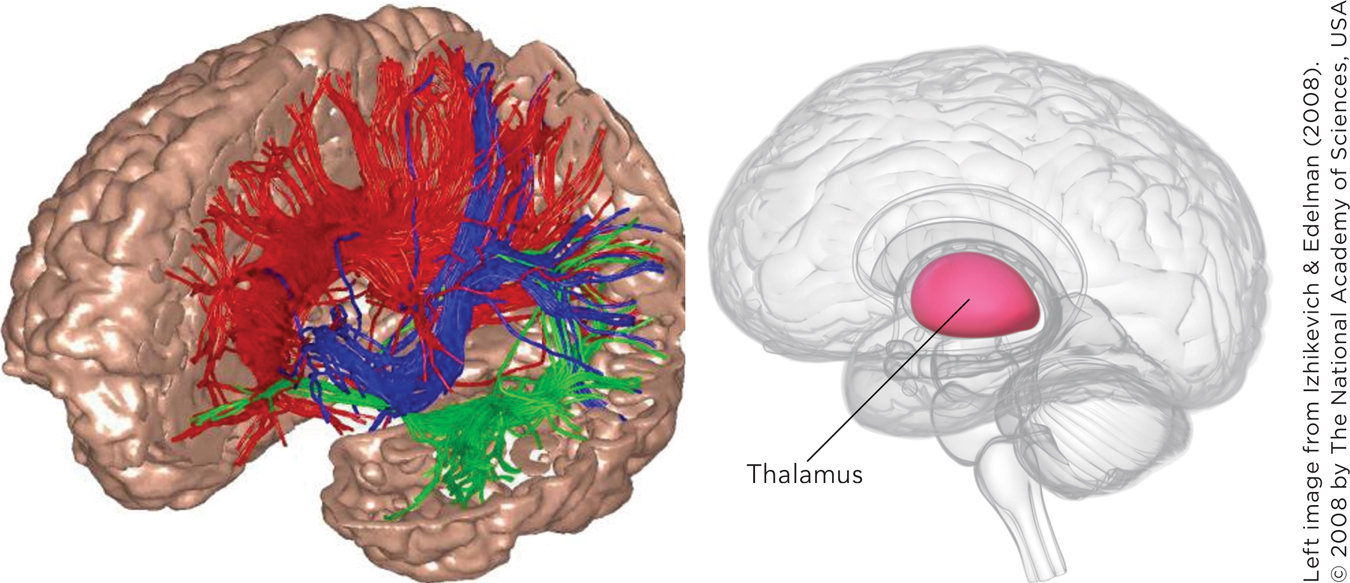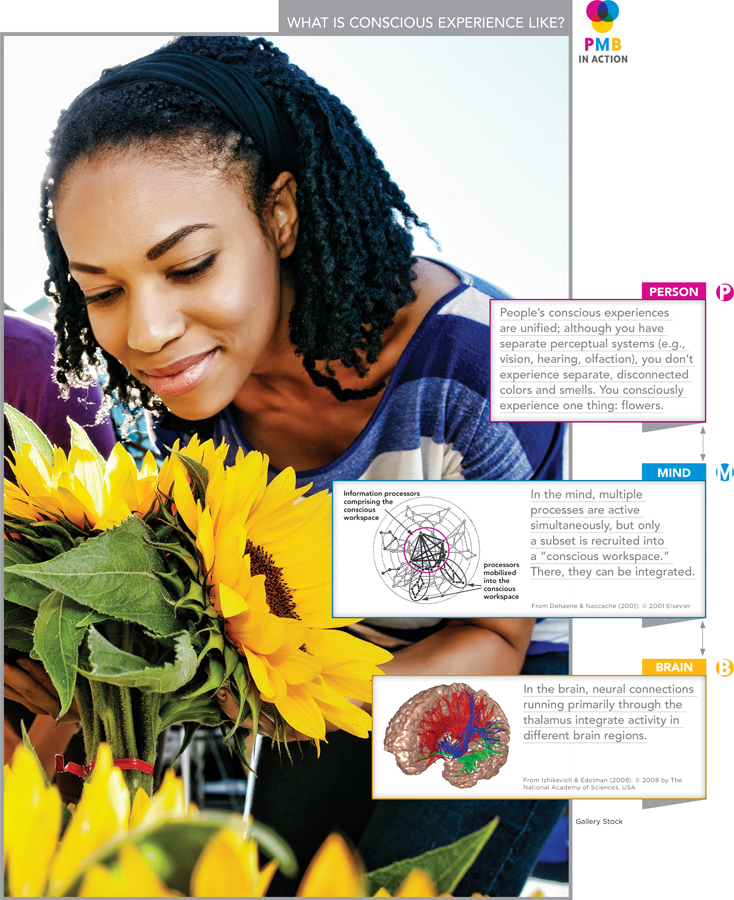9.4 The Biology of Consciousness
Why is there consciousness? It is not necessary for biological survival. Insects, worms, fish, and many other simple organisms survive just fine without conscious feelings. In fact, they exhibit complex behavior. Salmon, for example, migrate from fresh water to oceans and then manage to find their way back to their original freshwater location to reproduce, all without consciously experiencing their trip.
Let’s address this question by exploring the biology of consciousness. We’ll first look to the past and ask why consciousness evolved. Then we’ll turn to the present to see how activity in the contemporary human brain gives rise to conscious experience.

Evolution and Consciousness
Preview Questions
Question
 What is the evolutionary advantage of consciousness?
What is the evolutionary advantage of consciousness?
 How evolutionarily old is consciousness?
How evolutionarily old is consciousness?
Ever since the insights of Charles Darwin, scientists have recognized that organisms evolve through natural selection. Characteristics that are advantageous in a given environment—
THE EVOLUTIONARY ADVANTAGE CONSCIOUSNESS. One evolutionary advantage of consciousness involves decision making. Simple organisms lacking consciousness make simple decisions; they respond reflexively to specific stimuli that trigger specific responses. Organisms with consciousness, however, can do something more complex: combine different pieces of information and decide how to act based on this combination (Merker, 2005).
The ability to combine information promotes survival. Imagine an organism that has not eaten for some time and thus is low in bodily energy. Suppose it smells food in the vicinity but also hears a predator in the distance. What does it do? Ideally, the organism would combine two pieces of information, weighing one (presence of food) against another (possibility of predator). If it felt extremely hungry, the food was near, and the predator sounded far away, it would eat. If the predator sounded closer and the organism didn’t feel too hungry, it would flee. To combine the information, the organism needs to bring the various sounds, smells, and feelings of hunger together in the same mental place (Merker, 2005). Consciousness is that place. Conscious organisms, then, can make intelligent decisions that combine multiple pieces of information.
THE ORIGINS OF CONSCIOUSNESS. Consciousness is old. Mammals have it, and they have existed for at least 100 million years (Baars, 2005). Evidence suggests that consciousness is even older than that—
If you handle a lizard, its heart rate increases, which suggests that the lizard is consciously aware of the handling (Cabanac & Cabanac, 2000). A lizard’s brain has a cortex, which is needed for conscious experience. Other organisms with an evolutionary history older than lizards (e.g., amphibians, such as frogs) lack a cortex and do not react physiologically when handled, which suggests that they lack consciousness (Cabanac et al., 2009). Lizards have existed for about 300 million years. This combination of facts suggests that consciousness is roughly that old.
WHAT DO YOU KNOW?…
Question 13
True or False?
- GvJwYvjdYhfN1PXMIaffkLYePZTBgmbwH1p0M51FkGLIr4nMHTBmOUHMStvKQNh5
Consciousness enables us to combine information to make decisions, which surely aided in our survival.
- GvJwYvjdYhfN1PXMIaffkLYePZTBgmbwH1p0M51FkGLIr4nMHTBmOUHMStvKQNh5
A lizard’s brain has a cortex and its heart rate increases when handled, suggesting that it has consciousness.
- GXwmUalc+MmVEV01vc/nmD5XGu4PQotjGhjkLA6cIwpBO+8Tu3bXY3+/eMC4DJ9l
Consciousness is estimated to have existed for about 100 million years.

Consciousness and the Brain
Preview Question
Question
 What subsystems of the brain are necessary for an organism to have conscious experience? How do we know?
What subsystems of the brain are necessary for an organism to have conscious experience? How do we know?
Let’s turn from the past to the present—
FROM BRAIN MATTER TO CONSCIOUS EXPERIENCE. No question in science is more difficult to answer. In fact, it is so difficult that some argue it is unanswerable. Mysterianism is a theoretical claim that human beings lack the mental capacity to ever figure out how brain mechanisms produce conscious experience; it will always remain a mystery (McGinn, 1999).
The mystery lies in the stark difference between biological matter and conscious experience. If you look into the brain, you find cells and neurotransmitters. They function according to normal laws of physics. If you reflect on your conscious experience, you observe something completely different: thoughts and feelings that seem disconnected from ordinary physical matter. Consider these questions: How much does your current conscious experience weigh? About how big is it? These questions don’t even make sense. Conscious experience exists, yet it lacks physical properties such as mass and size. This disconnect between physical brain matter and conscious experiences makes it difficult even to imagine how the physical action of brain cells could create consciousness.
BRAIN SYSTEMS REQUIRED FOR CONSCIOUSNESS. Scientists cannot, at present, fully answer the difficult question of exactly how brain functioning produces conscious experience. Nonetheless, they have made progress on a slightly easier question: What subsystems of the brain are necessary for an organism to have conscious experience? Research identifies two critical aspects of brain functioning (Alkire, Hudetz, & Tononi, 2008; Edelman & Tononi, 2000).
Integrated activity. To have consciousness, organisms need a brain in which activity in different brain regions is coordinated, or “integrated.” No one structure in the brain independently produces consciousness. Rather, consciousness arises only when activity in numerous interconnected brain structures is integrated.
Thalamo-
cortical connections. Two brain structures whose interconnections are key to consciousness are the thalamus and the cortex. The thalamus, located near the center of the brain (see Chapter 3), receives inputs from multiple sensory systems, sends information out to multiple areas of the cortex, and receives input back from these regions of the cortex. These back- and- forth connections between the thamalus and cortex, known as thalamo- cortical circuits, integrate activity in multiple brain regions and thus serve as a basis for consciousness (Figure 9.3).

A famous case of an individual who lost consciousness supports the conclusion that intact thalamo-
376

THALAMUS, CORTEX, AND CONSCIOUSNESS. How do scientists know that thalamo-
Findings indicate that anesthetics induce unconsciousness by reducing activity in the thalamus. Consciousness ceases when thalamo-
Brain research thus shows that the integration of activity in large numbers of separate brain regions is needed for conscious experience. Interestingly, this biological fact is consistent with psychological experience. Psychologically, our experiences generally are coherent and unified. If a large green garbage truck whizzes past you, your sensory receptors receive different types of information: a flash of green light, a whiff of garbage, the sound of a truck engine, a breeze on your skin. Consciously, however, you experience one thing: a truck whizzing by. If someone asks, “What just happened?” you probably will not say, “There was a bright green light. I smelled some garbage. There was the sound of an internal combustion engine. And I felt a breeze.” Instead, you’ll report one coherent conscious experience: “A garbage truck.”
At a biological level, then, thalamo-


WHAT DO YOU KNOW?…
Question 14
S8L4ghQ9KXpvye4+dyRKghTzRWCPkrxAZd39m1FWnrGtoDG6s/qksk8PpnipueN95WTlmUrcZZVJ3WJVAGxUydCY7Xc1Tnf2W5Yr6VDaOvZzjoKiKED0L4Rhg6ayMVxZOQlmhMwOtlWGetTMV53TalrQWxzhepB/IYy0ef8lh9tOpalZQN0GxdR0Fx79Ev1JOwCOMEsLHMfqG0MBpj8pGCkHHB1OpR7Fgab7gmVFfClJgPhg/1tnIkh/LauIqAy2yqxdpyjSbFoAgx7HqpaicuwDFc8ioL8seytKj8Ea7IE667wjBkEA9UZ88THxSg4ex4SyNlIDlB4C6LALO1ErwsrdG0FmAW6HVI87gNt5zDkIB0tiTHINK ABOUT IT
Research shows that brain activity integrated by thalamo-
377
378
TRY THIS!
Now that you’ve learned about the psychology and biology of consciousness, it’s time to experience the powers, and limits, of the conscious mind in this chapter’s Try This! activity. Go to www.pmbpsychology.com now and complete the activity for Chapter 9: Consciousness. We’ll discuss it later in this chapter. ![]()